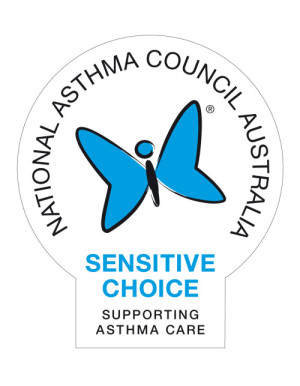Like 30-40% of Australians, I have allergies. At best they are an annoyance that make me feel a bit crappy sometimes, at worse they’ve triggered full blown asthma attacks in locations where medical help was not that easy to get too. Pretty scary stuff.

This post is brought to you by Sensitive Choice
Having Asthma is no joke, it can severely impact people’s lives and if not managed effectively it can even be fatal.
For most of my childhood my parents and I were unaware that I had allergy triggered asthma. I’d always be sneezing, have itchy eyes and throat, sometimes I’d cough and for many years we all just thought I was just really prone to getting colds. A couple of times I ended up in hospital but no one seemed to put two and two together.
Not until I was an adult and actually studying to be a pharmacist did I realise that, no, I didn’t constantly have a cold, but the many common allergens in my own home were causing me to have constant allergic reactions that were making me feel just awful.
Since then I’ve become much more aware of what triggers my allergies and asthma symptoms and where I can, I try to minimise my exposure.
Back then there were few information resources available to help my parents understand what was going on. Luckily now we have Sensitive Choice a fantastic educational and advisory website run by the National Asthma Council Australia. It’s full of information on asthma and allergy management, and even publishes a guide of products for use around the home that could help with asthma and allergy management by reducing exposure to environmental triggers.
Just like me, you may not even realise you or your child is suffering from allergic reactions, the information on Sensitive Choice may be just what you need to ‘join the dots’ to establish that that ‘continual sneeze, wheeze or cough’ may be reduced by simply changing things around the family home.
Here is what I’m allergic to and how I manage my exposure to help reduce my symptoms:

Dogs
This is a major trigger for me that will have me wheezing in just minutes. I grew up around dogs and love them, but sadly I don’t even pat them now because I know that I’ll break out in hives and my throat will start to itch and tighten. We’ll never have a pet at home now, which Emma is very sad about.
Pollen
This one is much more difficult to avoid. Hay fever can be really debilitating, but with advice from my friendly pharmacist (that’s me), I use a combination of preventative medications which combined with antihistamines tend to take the edge off my symptoms.

Dust Mites
They are the worst! Little microscopic buggers that feed off the skin cells we shed. They are almost impossible to eradicate, but making smart choices about soft furnishings in your home, you can reduce the places they like to hang out. Getting rid of older, shaggier carpets and fabric curtains, ditching my old doona for a Sensitive Choice approved new quilt and vacuuming regularly with a HEPA filter vac has really helped my symptoms.
Other triggers include, fragrances, cigarette smoke and cold and flu viruses.
All of these allergy triggers if not managed correctly can lead to asthma symptoms, there is no cure for asthma but it can be managed effectively with help from your doctor and pharmacist.
ASTHMA WINTER CHECKLIST
Colds and flu can hit hard if you have asthma. In fact, the common cold is behind around 4 out of 5 bad asthma attacks. Make sure your lungs are in the best possible shape for winter by following these steps.
I’m going to put my pharmacist hat on now to give you some advice to help you manage your asthma over the winter:
- Go for a checkup – See your doctor for an asthma review before the cold and flu season arrives and get a flu vaccination.
- Have an Asthma Action Plan and follow it. A written asthma action plan helps you recognise worsening asthma and tells you what to do in response.
- Know and Avoid triggers. Avoid cold air if it triggers your asthma, avoid contact with sick people and wash your hands to help avoid spreading germs.
- Use your preventer medication even if you feel well. Using your reliever more than twice a week or having asthma symptoms at night is a sign that your condition is worsening and you may need to be assessed.
- Ask your pharmacist to check if you’re using your inhaler correctly.
If you want to further educate yourself about how to minimise your family’s asthma and allergy symptoms, the Sensitive Choice website is a great resource.
Subscribe to their newsletter for tips and advice.

Look for the blue butterfly when shopping, stop for a moment and think about your family’s asthma and allergy care.
- Do you know your triggers?
- Are you taking steps to reduce your exposure to your triggers?
- Have you had an asthma and allergy review with your doctor recently?
- Do you follow your asthma or allergy action plan?






Hi Cinti,
thank you for your advice for asthma en allergy symptoms, I suffer of the both of them, and my cat has an allergic for things too.
But i have noticed that my moving closly to the seashore is really helping to have less problems.
But it helps those advice as a good reminder.
I hope it helps more people as well.:-D